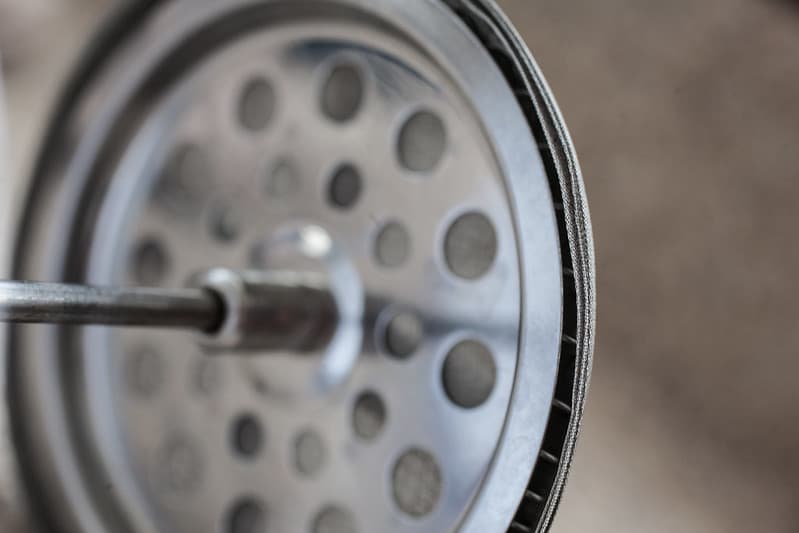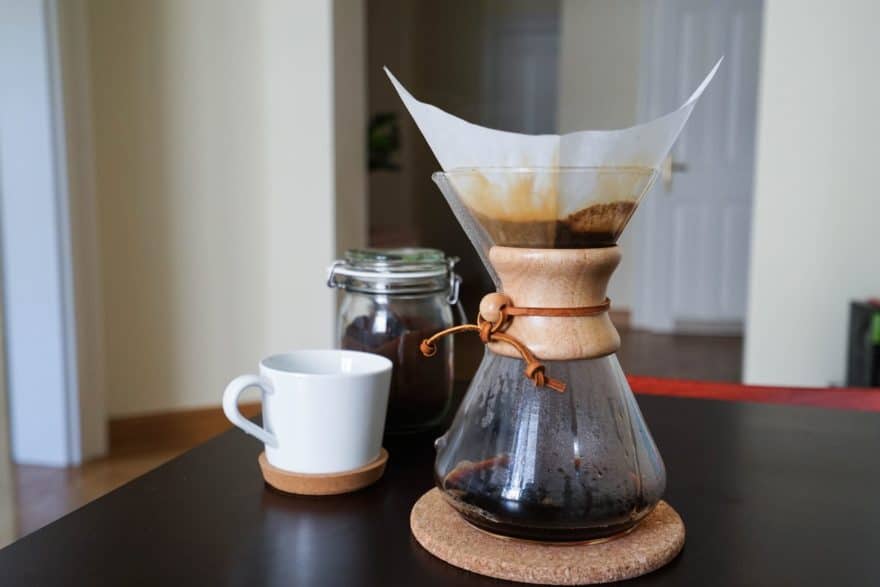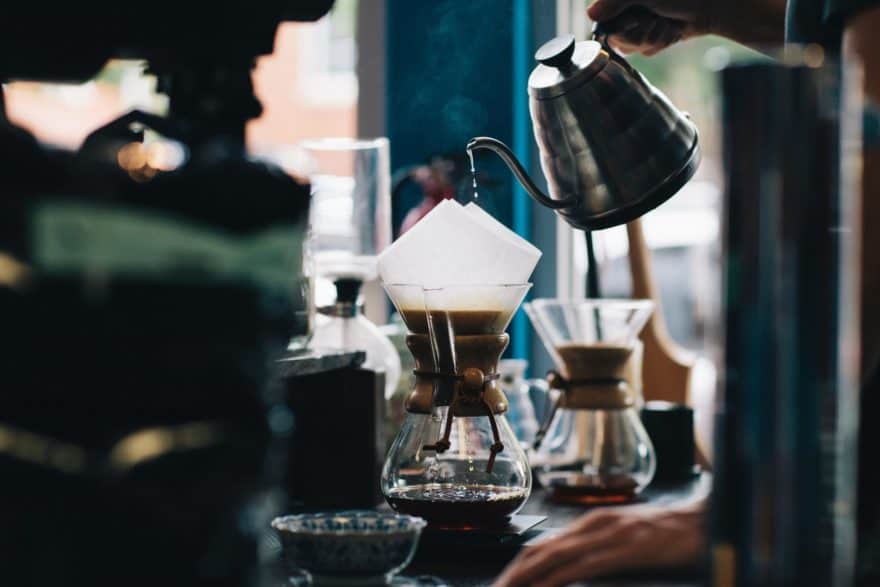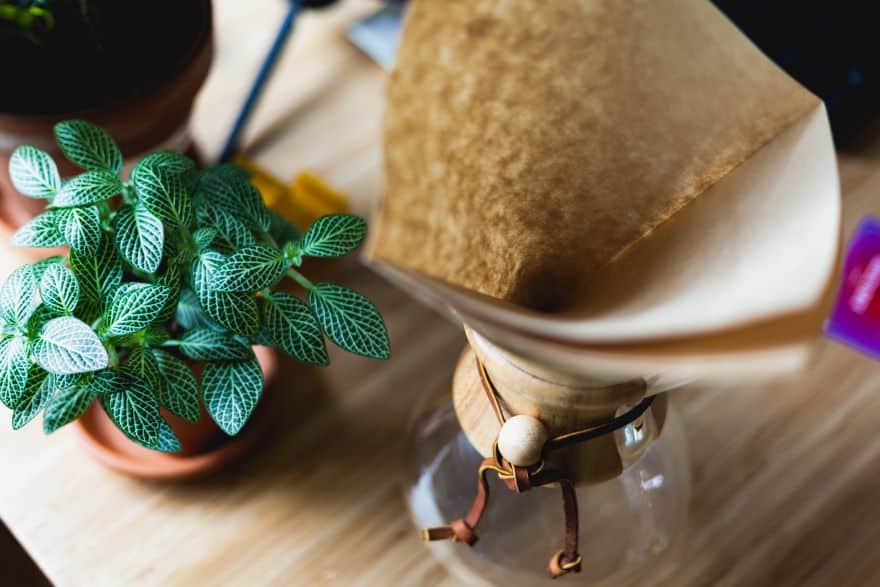Just so you know, as an Amazon Associate we earn from qualifying purchases made via bold red links, buttons or images.
Last Updated on December 13, 2023
The Chemex and the French press are two of the more popular tools for making coffee. These devices are great for different styles of brewing. Which one you choose will depend on the kind of coffee you want. Here we take a look at the French press vs. the Chemex and help you choose which is for you.
The basics of French press and Chemex
French press 101
The French press has been around since the 1800s. It’s sometimes called a coffee plunger. It’s ideal for those seeking a heavy, full-bodied brew—people who like to make their coffee dense, and taste that density. Its coffee doesn’t quite reach the sub-espresso level of a moka pot or AeroPress, but it’s probably next in line.

The press extracts coffee by immersing coarse grinds fully in hot water and letting them steep, usually in a borosilicate glass beaker. This distinguishes it from other methods that extract as hot water passes through the grounds. The plunger typically slides up and down through a hole in the lid, with a steel mesh filter at its end.
You don’t need a paper filter with a French Press, which makes it a nice sustainable choice.
A French press gives you good control over the brewing process. You can manipulate factors such as water capacity, weight of the coffee, grind size, water temperature, and steeping time. By playing with these variables, you determine how strong or weak your coffee is.
Because the grounds spend time fully immersed in the water and the coffee doesn’t pass through a paper filter, the oils released from the beans end up in your cup, giving your coffee a special flavor and silky mouthfeel.

The cylindrical shape of the press makes it easy to clean inside. Most people can fit their whole hand inside to sponge it clean. If you use it daily, I recommend a more thorough cleaning once a week in which you separate the parts of the plunger and wash them individually before screwing them back together. With this regular deep cleaning, every cup of coffee you produce will taste fresh.
Most manufacturers produce budget-friendly presses so you never have to break your bank to get a good press.
Pros:
- Easy to clean
- Produces heavy, flavorful coffee
- Environmentally friendly
- Versatile enough to make loose-leaf tea
Cons:
- A little coffee sediment might seep through the filter
- Coffee cools quickly
How to use a French press
The French Press is easy to use.
You want to use coarse coffee grounds rather than fine grounds. The mesh filter on a French press has relatively big pores, and it will allow finer grounds through, creating sediment in your coffee.

All you have to do is remove the lid and the plunger, add your coffee grounds and hot water, and stir. Then you place the lid and plunger back on and wait. Typical steeping time is about 4-5 minutes, and your grind size will dictate which end of this range you should be at. Smaller grind, shorter time. Larger grind, more time. If you need stronger coffee, increase your ratio of beans to water.
When everything has steeped, press the plunger down to the bottom with firm and steady pressure. This keeps the used grounds separate from the coffee. Your brew is ready to pour.
Chemex 101
The Chemex looks simpler than any other coffee maker you will use, as it’s basically a two-piece set. It does take some practice to get right, though!
It is essentially a pour-over device, but you don’t use a separate cone for your filter because the glass carafe’s unique hourglass shape gives it a built-in cone. Just pop in a filter and that’s all you need. You extract the coffee by slowly pouring water over grounds in the filter.
The Chemex coffee maker has been on the market since 1941, and remains as popular as ever.
You’ll love how the hourglass design looks on your countertop, along with the distinctive wooden collar which makes the carafe easy to handle when the coffee is hot.

Unlike the French press, the Chemex requires filters—and not just any filters. Chemex filters are thick and made specifically for the Chemex. They do a great job of filtering out both sediment and oils, so the coffee from a Chemex is really quite a contrast from what you get with a French press. It’s clean, bright and smooth. Chemex coffee filters are also compostable.
Pros:
- Clean coffee with no sediments
- Extremely stylish
- Pure, uncomplicated brewing method
Cons:
- Highly breakable
- Particular about its filters
- Requires a brush for proper cleaning
- Requires a little extra work to keep your coffee warm
How to use a Chemex
Although the Chemex works with all kinds of roasts, we love the way it brings out the pure, unadulterated flavor of a medium roast. You can really taste the terroir when you get this one right!
We have a comprehensive post on how to brew with a Chemex, but here’s a quick rundown…
Grind your beans to medium coarseness. Insert your filter and rinse it with hot water so that it doesn’t add its flavor into the taste of the coffee. Lift the filter to discard the water, then put it back in place and add your carefully weighed grounds.

First bloom your grounds with a little hot water—not enough for it to flow out of the funnel, just enough to make the grounds damp—and let it sit for 30 seconds. This allows the carbon dioxide to escape before you start brewing. After the coffee blooms, slowly add hot water in a circular motion, starting from the center. Ideally, you want to time your pour so that the last drop of coffee falls from the bottom of the filter about 3-4 minutes after you started. Then you can remove your filter and serve the coffee.
The differences between Chemex and French press
Brew time
These two coffee machines both take a short time to brew coffee. You only need to have your coffee beans, hot water, and a filter (for the Chemex). The Chemex pour is a little bit shorter than the French press steep; however, if you bloom your Chemex coffee it adds a little time. (Of course, smart French press brewers bloom their grounds as well.) And then you have the extra time it takes to moisten the Chemex filter before starting.
All in all, we’re going to call it even.
Filtration
The Chemex uses a paper filter, which makes it a little less environmentally friendly. Nevertheless, the filter ensures you have clean coffee by trapping all the particles and sediment. It also makes it easy to throw away used grounds, because you can just toss them with the filter.

The stainless steel filter of the French Press is more environmentally friendly but usually allows some sediment into your cup. The sediment means you’ll probably want to leave the last sip behind.
Usability and convenience
You have to be present when making coffee with either of these devices. You can’t set it and forget it. On the plus side, you get a lot of control and can learn something about how to brew.
The Chemex requires a little more participation, with the circular pouring of boiling water over the coffee in the filter. The French press can be left alone briefly as you steep, and before you take the plunge.
Both methods require pretty close attention to the clock, or you risk improper extraction.
Taste
The French press is ideal for bold, strong, full-bodied coffee. The Chemex is best for clean coffee with a lot of flavor nuance.
Which device should you choose?
The French press and Chemex both make great coffee and are reasonably affordable. Depending on your coffee preferences and your budget, one might serve you slightly better than the other.
- You are on budget, but still want a brewer that will last. Glass carafe aside, most French presses are quite durable yet priced affordably. If you take care of it, you can use it for decades.
- You need a device that’s easy to clean. The cylindrical design of the French press allows for easy cleaning. You can take it apart quickly to separate the parts for thorough cleaning.
- You want a very eco-friendly product. The press doesn’t use paper filters. The only thing you throw out after brewing is the spent coffee grounds.
- You want strong, full-bodied coffee.
Buy a Chemex if:
- You want less mess when cleaning. After brewing, you simply throw away the coffee grounds and filter before cleaning the device.
- You like hands-on brewing. You can learn a lot about grinding and extraction by using a Chemex.
- You love nuanced coffee flavors. The Chemex’s thick filter removes oils and sediment, leaving the pure taste of coffee.
One thing that the French press and Chemex share is their affordability. One is a glass container that uses a filter, the other is a glass container with a built-in filter, plunger, and lid. The only other piece of equipment you might need is a gooseneck kettle for your pour-over.
Once you have chosen either the French press or Chemex, be sure to observe all the rules of coffee making. Ensure you use fresh grounds, watch your coffee-to-water ratio, observe the brewing time, and use filtered water to have the best results.



Both coffee makers are good, however the
Chemex makes a better cup, (taste wise)
than the French press.
I’m very pleased with my Chemex.
Joe Falcone